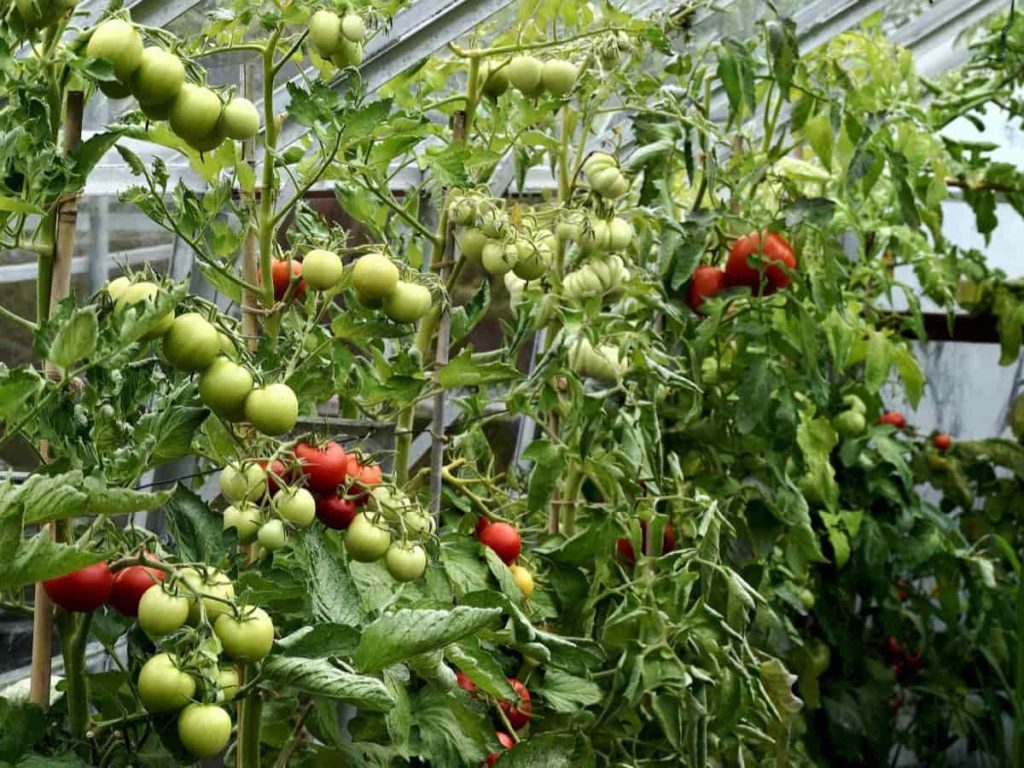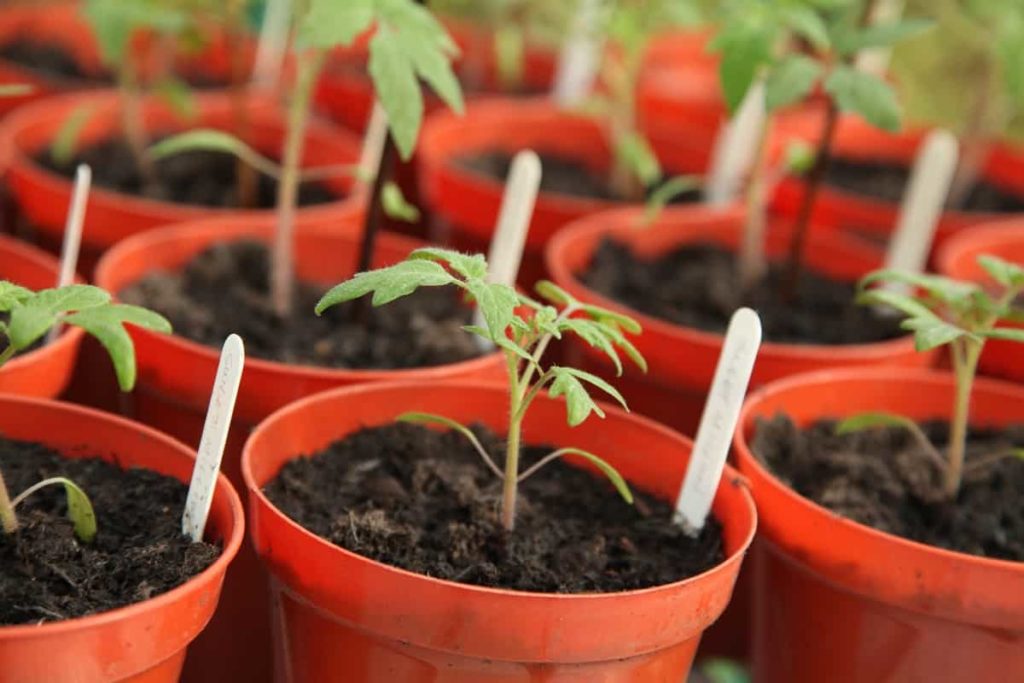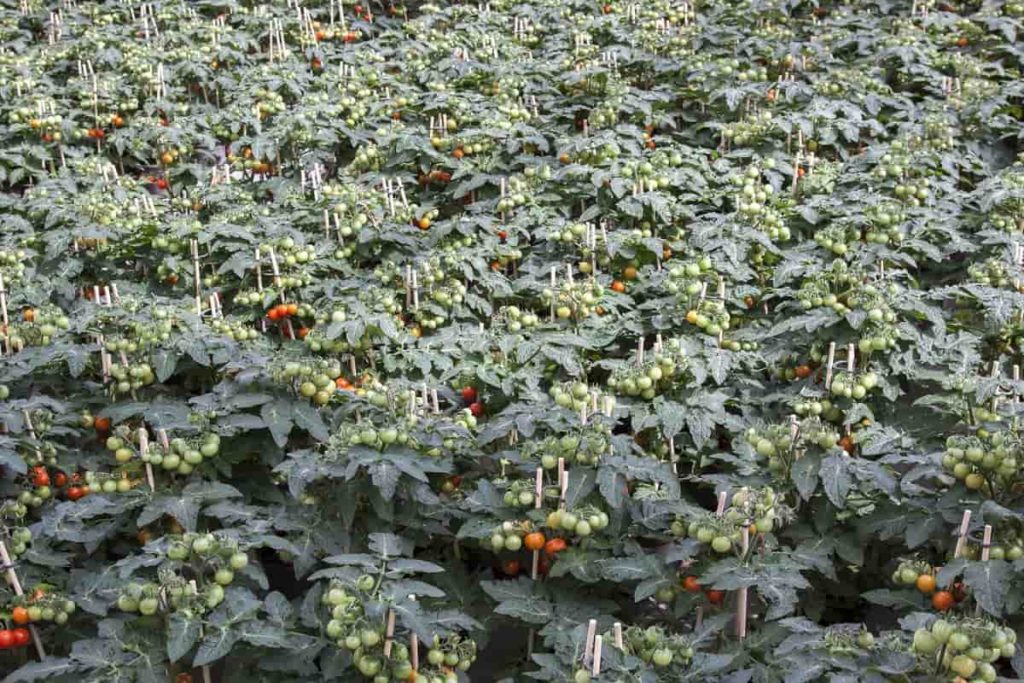Although tomatoes thrive in warm conditions, unpredictable spring weather might cause planting delays and stunt the plants’ development. Here are some of the finest strategies and tips to speed up the growing season and enjoy those first ripe fruits sooner. Below we learn how to grow tomato plants faster and the best tips to increase the flowering, fruiting, and yield.

How to grow tomato plants faster
Good soil preparation is essential for tomato plants
The key to successful tomato cultivation is proper soil preparation before planting. Tomatoes need deep, fertile soil with good drainage. As a result of this soil amendment, the plant’s roots are free to spread out and take up a greater volume of soil, where they can more easily access the full complement of available nutrients. It would help if you had the beds ready in plenty of time.
Before beginning to work with the soil, have a test performed. With soil testing, gardeners can learn what nutrients are deficient in their soil and what nutrients are abundant. It also provides information on the soil’s pH range, which is useful for growing tomatoes. The depth of your garden bed is quite important. Soil depths between 12 and 24 inches allow root systems to develop. Your plant beds will benefit greatly from a layer of compost at least 6 inches thick. High-quality compost offers most of the nutrients plants need to develop.
Don’t crowd the seedlings
Tomato seedlings need much space to grow. This implies you should only keep the strongest seedling in each cell or little container. Cut down the smaller, weaker seedlings to make room for the strongest ones. Their development is stunted by the close quarters, which causes stress and eventually sickness. After the first true leaves appear on a tomato seedling, it is time to transplant it to a container 4 inches in diameter.
Provide adequate light for your tomato plants
Young tomato plants want bright, direct sunlight. Winter days are short, so even if you put them next to a bright window, they may not get enough light. Artificial plant illumination for 14–18 hours per day is recommended unless the plants are grown in a greenhouse. Keep immature tomato plants a couple of inches away from fluorescent grow lights to ensure they develop into stocky rather than spindly ones. As the seedlings develop, you’ll have to adjust the lighting higher (or the plants lower). When transplanting, place them in the garden’s sunniest area.
In case you missed it: Why are my Tomatoes Rotting on the Bottom and Top: Blossom End Rot, Symptoms, Remedies, and Solutions

Start your tomato plants early for a quick harvest
It’s best to start the seeds inside around six to eight weeks before the last spring frost is expected. Once the danger of frost has gone, the tiny seedlings are hardened off and placed in garden beds. Putting tomato seeds inside offers you larger transplants that develop and yield fruit faster. However, you must ensure that the seedlings have all they need to flourish, including enough light (via a grow lamp or bright window).
A container of 6 to 8 inches in diameter, steady hydration, and continuous treatments of liquid organic vegetable fertilizer. There is a risk of having to postpone harvesting due to weak, water-stressed seedlings that were sowed early. Tomato plants can be overwintered using one of these techniques, allowing for an early harvest the following year.
Warm the soil beforehand
Without warm soil and air, they won’t develop properly. Soil preparation may be sped up by covering the area with black or red plastic a few weeks before planting. Tomatoes will mature sooner if the soil is warmed by a few more degrees. Some studies have shown that red plastic mulch can improve tomato harvests, and you can remove the plastic before planting.
Provide your soil with calcium
Spot ripening occurs in tomatoes when the fruit begins to turn black or brown just before it flowers. Blossom end rot is often brought on by a lack of calcium and inconsistent watering. Many gardeners still put eggshells in their soil even though it is preferable to verify the calcium content of the soil before planting. Calcium carbonate accounts for over 96% of an eggshell’s composition. You can make a powder out of ground eggshells if you save them. Then, when you’re ready to plant your tomato seedlings, sprinkle a little powder into each hole.
Bury the tomato stems deep
The ideal planting depth for tomato plants is somewhat deep. Before planting, inspect the stems closely; you’ll see microscopic, fibrous hairs that run the length of the stem. They are not hairs but rather new potential plant roots. After being buried, they begin to grow roots. Tomatoes benefit from having their roots established at a deeper depth during planting.
This implies that the plants are getting a greater share of the soil’s nutrients, increasing their yield. Tomato seedlings should have their lowest leaves clipped off before being planted. Then, bury the tomato seedling’s stem slightly below the lowest leaves. Avoid getting soil on the leaves since this might spread diseases.
In case you missed it: How to Grow Tomatoes from Seeds: Starting from Scratch, A Beginners Guide to Indoors, Outdoors, and in Pots

Harden off your tomato plants
Tomatoes can develop slowly because of transplant shock. Tomatoes that have just been transplanted often experience a growth delay or stunting due to the stress of adapting to their new surroundings. To ensure a robust tomato plant, it is advisable to harden off the transplants by leaving them outdoors in the sun for longer before planting. This will help them adjust to their new surroundings and prepare for unexpected weather changes.
Tomatoes should be hardened off approximately a week before transplanting. You can harden off your tomatoes by exposing them to the outside for short periods each day for a week. You should wait until they have correctly adjusted to your garden’s environment before planting them there. You can bury your transplants to their first true leaves when you plant them in the garden. The result will be healthy root development, allowing the plant to draw in enough water and nutrients to grow quickly and robustly.
Feed your tomato plants adequately
Tomatoes are heavy feeders, meaning plants need many minerals for optimal growth. Tomatoes that develop slowly could benefit from a soil test to see whether the soil lacks any essential nutrients. In addition to stunted development, yellowing leaves sometimes indicate a nutritional deficit in plants. Tomatoes need many nutrients, so make sure the bed has much compost.
In addition, you can put some compost in the bottom of the hole before you place the transplant. Most gardens are deficient in nitrogen, which is essential for plant growth. Soil nitrogen can be increased by growing legumes like peas and beans alongside other plants. In addition, if you have access to hens or horses, their manure can be added to the compost bins as a natural nitrogen source.
Remove the bottom leaves
You should prune the lower leaves when your tomato plants are between two and three feet tall. The oldest leaves are the ones most susceptible to fungal infections. As the vegetation matures, the lowest leaves get the least quantity of sunlight and wind. These leaves are low to the ground, making them vulnerable to contamination by viruses in the soil. The spread of fungal infections can be stopped if they are eliminated. Daily spraying with compost tea is also useful in preventing fungal diseases.
In case you missed it: How to Grow Tomatoes in Michigan: Planting to Harvesting Guide

Prune your tomato plants
Many people wrongly believe that trimming is exclusively done on trees and plants. Extra severe trimming of tomato plants results in more fruitful plants and higher yields. To begin, the lowest branches will be pinched. You cut off the bottom branches before planting the stem deeply. Tomatoes must focus on developing strong roots; therefore, pinching off the flowers is a must.
Suckers should be cut out of the leaf as the next step. When all the suckers are cut off, the plant has little choice but to put its resources towards expanding, blooming, and bearing fruit. You should prune the lowest branches as your plant develops. It’s important to prune away non-fruiting branches so the plant can focus on generating fruit. It prevents the leaves from falling on the ground, where they might be exposed to pathogens.
Pest and disease control for your tomato plants
Pests like slugs, hornworms, whiteflies, and aphids are happy to munch on your tomato plants. A ravenous hornworm can eat your plant to the ground, but these pests will, at the very least, sap its vital nutrients, stunting its growth. If you detect insect damage, identify the pest. Keeping pests away from your tomatoes before they cause damage is ideal. Tomatoes can be protected from pests near buckwheat, Alyssum, or clover. You may also use floating row coverings to prevent pests from damaging your tomato crop.
Since each tomato blossom includes both male and female organs, floating row covers can be left in place for the duration of the growing season without affecting the crop. Several diseases can affect tomatoes and, at least, hinder the plant’s development. Damping-off, blight, damping-off, and bacterial leaf-spot are some diseases that can affect your tomatoes. Find out what’s wrong and how to fix it by consulting the internet or a local garden center if you notice your plants are ailing.
In case you missed it: The Best Fertilizer for Tomatoes in Pots

Cut away any infected branches or leaves. If they are ill, sets may need to be cut down to their roots. Many fungal concerns can be avoided by maintaining a dry growth environment and allowing enough air and light to permeate. Maintaining healthy plants requires careful watering and enough space between plants.
Water your tomato plants carefully
The development of your tomatoes can be stunted by either underwatering them or overwatering them. The plant won’t be able to get the oxygen and nutrients it needs to develop quickly if it’s underwatered. If you overwater, the roots won’t get enough oxygen, and they won’t be able to take as much water or rot. How much water, therefore, is optimal? If your tomatoes are receiving adequate water, you should be able to determine by sticking your finger into the soil anywhere from 2.5 cm to 5 cm (1 inch to 2 inches).
The soil needs watering if it is dry. Repeat the test tomorrow if you get the impression that the ground is still damp. It’s essential to keep an eye on the soil water level of your containerized tomatoes since the soil dries out more quickly there than in the garden. If you want ripe tomatoes, stop watering them around the end of July. Tomatoes might mature more quickly in response to the drought, which can increase your yield.
Stake your tomato plants
Without a shadow of a doubt, tomato plants need staking. Tomato plants can reach heights of eight feet; without stakes or other stabilizing mechanisms, the plant would eventually tumble and likely break in two. Tomato plants that are allowed to contact the ground are more likely to get infected by harmful bacteria and fungi.
The soil is home to many diseases, and if a leaf comes into contact with the soil, your plant will quickly get sick. A cage, stake, or trellis is necessary for tomato plants. Setting up the cage or other support structure as soon as possible after planting the tomato plant is preferable. Too much waiting might harm the root system while putting the cage or stake. When you use a reliable plant support system, your yield increases to four times as much as without it.
Frequently asked questions on how to grow tomato plants faster (FAQ)
Why are my tomato plant growing very slowly?
Inadequate watering or poor soil are likely culprits if your tomato plants grow slowly. Don’t let your plants dry out. Be sure that your soil has sufficient drainage and a pH that is somewhat on the acidic side. Never leave your tomato plants out in the cold since doing so will significantly slow or stop their development.
How long does it take tomatoes to grow from seed?
It might take anything from 60 days to over 100 days from planting to harvesting tomatoes. Due to its extended growing season, most gardeners sow “starter plants” or transplants instead of seeds in spring. Transplants can be purchased from a garden store or nursery and grown from seed inside.
What fertilizer is best for tomatoes?
Use a high-quality fertilizer if you have poor soil or don’t want to deal with manure. Nitrogen (N), phosphorus (P), and potassium (K) levels are indicated by three digits on the package; pay attention to them (K). A high-phosphorus fertilizer, denoted by a big central number, is favored by certain gardeners. Alternatively, you can use a tomato-specific fertilizer, which often has a ratio of 3-4-6 or 4-7-10 and is designed to promote rapid growth and fruiting.
In case you missed it: Best Tomato Varieties in India: Hybrid, Rainy Season, and High Yield

Avoid over-fertilizing since that will have the worst possible effect. Never apply too much fertilizer; too little is usually preferable. Fertilizers should help plants thrive, even if manure is worked into the soil before planting. First, create a hole and then fill it with the manufacturer-recommended quantity of fertilizer. To prevent the fertilizer from harming the roots, it must be buried under fresh soil.
Tomatoes need fertilizer side-dressed every 3 to 4 weeks afterward. To side-dress tomatoes, create a shallow trench around the plant with the point of your hoe, spacing it at least 5 to 6 inches (12 to 15 centimeters) from the stem. 1 to 1 1/2 teaspoons (15-21 ml) of fertilizer should be scattered in the furrow around each plant. Soil and mulch should be spread over fertilizer. Care must ensure that the leaves and stems are not contaminated with fertilizer. After fertilizing, water the well to help the nutrients reach the plant’s roots.
How often should tomatoes be watered?
Tomatoes planted directly in the ground have longer, deeper roots that are better able to reach the water. Tomatoes need plenty of water after planting to ensure the soil is at an appropriate moisture level for growth. It’s best to water plants first in the morning at the beginning of the growing season. As temps rise, water your tomato plants two times a day. Tomatoes are grown in a garden usually need between one and two inches of water each week. More water is required for container-grown tomatoes than those planted in the ground.
Increased water evaporation occurs when soil is contained in containers because of the increased temperature. As a general rule, water containers until water drains easily from the bottom. Morning watering and afternoon soil checks are advised. Insert your finger one inch below the soil’s surface to see whether it needs watering. Applying organic mulch around tomato plants helps keep moisture and prevents loss. Saving time and effort on watering is a direct result. These are some of the best tomato growing tips in pots.
Conclusion
When the tomatoes on your vines ripen, you should check on them daily and pick those almost ready to eat. Tomatoes can be easily ripened inside, avoiding the risks of insect damage and spoilage that come with allowing them to mature in the garden.
- Gardening Techniques in Planting Vegetables
- Where to Place Indoor Plants in Your Home
- How to Grow Tomatoes Organically at Home: A Comprehensive Guide
- Organic Gardening on a Budget: Low-Cost Methods and Materials
- Gongura Seed Germination and Planting Methods
- Cabbage Seed Germination and Selection
- Broccoli Seed Germination and Selection
- Asparagus Seed Germination and Variety Selection
- Seasonal Flower Gardening: Best Practices for Spring, Summer, Fall, and Winter
- How to Grow Hibiscus from Flower
- Plantation Ideas for Home Decoration: A Beginners Guide
- Flower Garden Designs and Layouts for Beginners
- Planting and Spacing Techniques in Papaya: A Beginner’s Guide
- Growing Gold: Essential Techniques for Planting Pineapples
- How to Make Kalanchoe Plant Bushy: Home Remedies and Solutions
- 11 Reasons Why Your Gardenia is Not Blooming: Home Remedies and Solutions
- Eco Elegance: The Guide to Designing a Drought-Tolerant Landscape
- Gardening on a Slope: Strategies for Hillside Landscaping
- Nourish and Flourish: Top Organic Mulches for Thriving House Plants
- Everything You Want to Know about Indian Mogra Flower: Discover Uses and Growing
- Green Thumb Success: Expert Tips for Cultivating Greenhouse Pumpkins All Year Round
- Maximize Growth & Flavor: The Ultimate Guide to Companion Planting in Herb Gardens
- How to Control Rhododendron Problems Naturally: Home Remedies and Organic Ways to Fix Them
- Natural Magic: The Remarkable Benefits of Cinnamon for Plants
- Best Steps to Revive Dying Tulip with Natural and Organic Treatment
- 10 Reasons Why Your Angel Trumpet is Not Blooming: Remedies and Treatment
- How to Fix Periwinkle Leaf and Flower-Related Problems: Natural Remedies and Solutions
- How to Fix Zinnias Leaf and Flower Problems: Discover Natural and Home Remedies
- Organic Steps to Induce Lemon Tree Flowers: A Comprehensive Guide
- Bloom Booster: Crafting the Perfect Homemade Bougainvillea Fertilizer
- Optimizing Growth: A Guide to Applying NPK Fertilizer for Potted Plants
- 10 Best Homemade Fertilizers for Rubber Plant: DIY Recipes and Application Method
- How to Boost Female Pumpkin Flowers: Effective Steps for More Flowers and High Yields
- Transform Your Indoor Garden: Top Benefits of Pink Salt for Houseplants
- 10 Best Homemade Fertilizers for Peacock Plants (Calathea): Easy DIY Guide
- Unlock Blooms: 9 Reasons Why Your Potted Chrysanthemum is Not Blooming